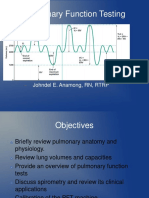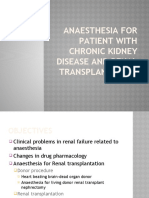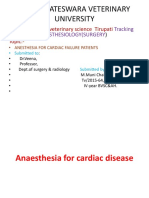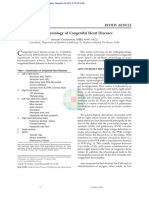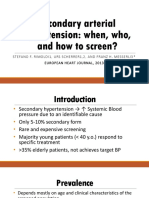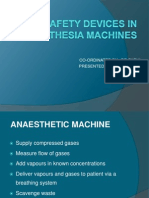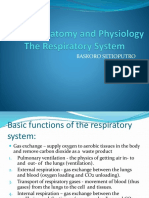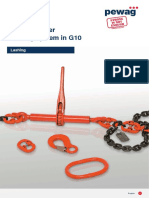0 ratings0% found this document useful (0 votes)
338 viewsRespiratory Failure (KK 2a)
Respiratory Failure (KK 2a)
Uploaded by
IlaJako StefanaticThis document discusses respiratory failure, which occurs when one or both of the gas exchange systems (air entering the lungs or oxygen entering the blood from the lungs) is inadequate. There are two main types - hypoxemic respiratory failure, where oxygenation is inadequate, and hypercapnic respiratory failure, where ventilation is inadequate and carbon dioxide levels rise. Causes can include issues with the airways, lungs, chest wall, nervous system or muscles. Diagnosis involves blood gas analysis and other tests. Treatment focuses on addressing the underlying cause, providing oxygen therapy, mobilizing secretions, mechanical ventilation if needed, medications, nutrition support, and careful nursing care of patients on ventilators to prevent complications.
Copyright:
© All Rights Reserved
Available Formats
Download as PPTX, PDF, TXT or read online from Scribd
Respiratory Failure (KK 2a)
Respiratory Failure (KK 2a)
Uploaded by
IlaJako Stefanatic0 ratings0% found this document useful (0 votes)
338 views29 pagesThis document discusses respiratory failure, which occurs when one or both of the gas exchange systems (air entering the lungs or oxygen entering the blood from the lungs) is inadequate. There are two main types - hypoxemic respiratory failure, where oxygenation is inadequate, and hypercapnic respiratory failure, where ventilation is inadequate and carbon dioxide levels rise. Causes can include issues with the airways, lungs, chest wall, nervous system or muscles. Diagnosis involves blood gas analysis and other tests. Treatment focuses on addressing the underlying cause, providing oxygen therapy, mobilizing secretions, mechanical ventilation if needed, medications, nutrition support, and careful nursing care of patients on ventilators to prevent complications.
Original Description:
respiratory
Original Title
Respiratory Failure (Kk 2a)
Copyright
© © All Rights Reserved
Available Formats
PPTX, PDF, TXT or read online from Scribd
Share this document
Did you find this document useful?
Is this content inappropriate?
This document discusses respiratory failure, which occurs when one or both of the gas exchange systems (air entering the lungs or oxygen entering the blood from the lungs) is inadequate. There are two main types - hypoxemic respiratory failure, where oxygenation is inadequate, and hypercapnic respiratory failure, where ventilation is inadequate and carbon dioxide levels rise. Causes can include issues with the airways, lungs, chest wall, nervous system or muscles. Diagnosis involves blood gas analysis and other tests. Treatment focuses on addressing the underlying cause, providing oxygen therapy, mobilizing secretions, mechanical ventilation if needed, medications, nutrition support, and careful nursing care of patients on ventilators to prevent complications.
Copyright:
© All Rights Reserved
Available Formats
Download as PPTX, PDF, TXT or read online from Scribd
Download as pptx, pdf, or txt
0 ratings0% found this document useful (0 votes)
338 views29 pagesRespiratory Failure (KK 2a)
Respiratory Failure (KK 2a)
Uploaded by
IlaJako StefanaticThis document discusses respiratory failure, which occurs when one or both of the gas exchange systems (air entering the lungs or oxygen entering the blood from the lungs) is inadequate. There are two main types - hypoxemic respiratory failure, where oxygenation is inadequate, and hypercapnic respiratory failure, where ventilation is inadequate and carbon dioxide levels rise. Causes can include issues with the airways, lungs, chest wall, nervous system or muscles. Diagnosis involves blood gas analysis and other tests. Treatment focuses on addressing the underlying cause, providing oxygen therapy, mobilizing secretions, mechanical ventilation if needed, medications, nutrition support, and careful nursing care of patients on ventilators to prevent complications.
Copyright:
© All Rights Reserved
Available Formats
Download as PPTX, PDF, TXT or read online from Scribd
Download as pptx, pdf, or txt
You are on page 1of 29
Respiratory Failure
Siswoyo & Wantiyah
Resp Failure:one or both exchanging systems
is inadequate (air to lung or lung to blood)
Blood Supply to Lung
Respiratory Failure
Not a disease process, sign of severe dysfunction
Predisposing Factors:
Airways/alveoli
CNS
Chest wall
Neuromuscular
Commonly defined in terms of ABGs:
PO2 of less than 60 mmHg
PCO2 greater than 45 mmHg
Arterial pH of less than 7.35
Classification of Respiratory Failure
Hypoxemic Respiratory Failure
Oxygenation failure- inadequate O2 transfer
between alveoli & pulmonary capillary bed
PaO2 60 mm Hg or less on 60 % O2
Inadequate O2 saturation of hemoglobin
Causes tissue hypoxia > Metabolic acidosis; cell
death; decreased CO; impaired renal function
Common causes: disorders that interfere with O2
transfer into the blood- respiratory or cardiac
system
Hypoxemic Respiratory Failure
Mechanisms that may lead to Hypoxemia:
1. Mismatch ventilation & perfusion (V/Q mismatch)
V/Q: Volume blood perfusing lungs each minute
Each ml of air for each ml of blood
1:1= V/Q ratio of 1
Causes of V/Q mismatch:
Ventilation portion blocked (secretions in
airway/alveoli, airway/alveolar collapse, decreased
movement chest/ventilation)
Perfusion portion blocked (pulmonary embolus)
Hypoxemic Respiratory Failure
Range of ventilation to perfusion (V/Q relationship)
A. Absolute shunt, no
ventilation fluid in alveoli
B. Ventilation partially
compromised- secretions
C. Normal lung unit
D. Perfusion partially
compromised by emboli
obstructing blood flow
E. Dead space: no
perfusion- obstruction of
pulmonary capillary
Hypoxemic Respiratory Failure
Mechanisms that may lead to Hypoxemia:
2. Shunt- Extreme V/Q mismatch
Occurs when blood
leaves heart without gas
exchange
Types:
1. anatomic shunt: O2
blood does not pass
through lungs
2. intrapulmonary shunt-
alveoli fill with fluid
Treatment: Mechanical
ventilation to force O2
into lungs; treat cause
Hypoxemic Respiratory Failure
Mechanisms may lead to Hypoxemia:
3. Diffusion limitations
Alveoli membrane
thickened or destroyed
Gas exchange across
alveolar-capillary
membrane cant occur
Classic sign: hypoxemia
present during exercise,
not at rest
Treat the cause such as
pulmonary fibrosis;
ARDS
Hypoxemic Respiratory Failure
Mechanisms may lead to Hypoxemia:
Clinical manifestations of hypoxemia
Specific: Respiratory:
Nonspecific: Cerebral, cardiac, other
Treatment: treat cause, O2 and mechanical
ventilation
Hypercapnic Respiratory Failure
Ventatory failure: Inability of the respiratory system to
ventilate out sufficient CO2 to maintain normal PaCO2
PaCO2 greater than 45 mm Hg, Arterial pH less than 7.35
PCO2 rises rapidly and respiratory acidosis develops,
PO2 drops more slowly
Common causes include disorders that compromise lung
ventilation and CO2 removal (airways/alveoli, CNS, chest
wall, neuromuscular)
Clinical manifestations: specific respiratory, nonspecific
of cerebral, cardiac, neuromuscular
Treatment: adeq O2, airway, meds, treat underlying cause,
nutrition
Collaborative Care for Respiratory Failure:
Diagnostic tests
History/physical assessment
Pulse oximetry
ABG analysis
Chest X-ray
CBC, sputum/blood cultures, electrolytes
EKG
Urinalysis
V/Q scan- if pulmonary embolism suspected
Hemodynamic monitor/pulmonary function tests
Collaborative care for Respiratory Failure
Respiratory Therapy
Main treatment- correct underlying cause & restore
adequate gas exchange in lung
Oxygen Therapy (Maintain PaO2 at least 60 mm Hg,
SaO2 90%)
Mobilization of secretions
Effective coughing & positioning
Hydration & humidification
Chest physical therapy
Airway suctioning
Positive pressure ventilation
Noninvasive positive pressure ventilation
Intubation with mechanical ventilation
Collaborative Care for
Respiratory Failure cont
Drug Therapy
Relief bronchospasm; reduce airway inflam and
pulmonary congestion; treat pulmonary infections;
reduce anxiety, pain
Medical supportive therapy
Treat underlying cause
Nutritional therapy
Enteral; parenteral
Protein and energy stores
Collaborative Care: Artifical airways-
tracheostomy and endotracheal tubes
Endotracheal tube
Taping and inline suctioning of an
endotracheal tube
Exhaled C02 (ETC02) normal 35-45
Used when trying to wean
patient from a ventilator
Independent Lung Ventilation
Collaborative Care:
Mechanical Ventilation
Provide adeq gas
exchange
Criteria to put on vent
RR > 35-45
pCO2 >45
pO2 <50
Types- Positive, Neg
Types: Negative pressure ventilator
Types: Positive pressure mechanical
ventilation with endotracheal tube (PPV)
Complications/Nursing Care of
Positive Pressure Mechanical ventilation
Cardiovascular: decreased CO; inc intrathoracic pressure
Pulmonary: Barotrauma; Volutrauma; alveolar
hypoventilation/hyperventilation; ventilator-associated
pneumonia
Sodium and water imbalance
Neurological: impaired cerebral bl flow>IICP
Gastrointestional: stress ulcer/GI bleed; gas; constipation
Musculoskeletal: dec muscle tone; contractures; footdrop;
pressure ulcers from BR
Psychosocial: physical & emotional stress; fight vent
Other problems
when on mechanical ventilation
Machine disconnection or malfunction
Nutrition needs
Nursing assessment specific to
Respiratory Failure
Assess both airway and
lungs
Refer to hypoxic and
hypercapnic respiratory
failure symptoms
Data:
Subjective data
Objective data
Nursing Diagnoses
Impaired spontaneous ventilation
Impaired gas exchange r.t mismatch
perfusion-ventilation
Relevant Nursing Problems related to
Respiratory Failure
Prevention of acute respiratory failure
Nursing Care Plans
Gerontology considerations
Nursing Care Plans Mechanical ventilation
Suctioning procedure and oral care
29
You might also like
- Bhrigu - Sarala - Padatthi - From Rule 1 Thru Rule 30 - Part 1Document13 pagesBhrigu - Sarala - Padatthi - From Rule 1 Thru Rule 30 - Part 1Sastry Karra96% (70)
- Vasopressors and InotropesDocument31 pagesVasopressors and InotropesReza Prakosa SedyatamaNo ratings yet
- John PFTDocument231 pagesJohn PFTAlexander Santiago ParelNo ratings yet
- Etihad RailDocument8 pagesEtihad RailMuhammad AbidNo ratings yet
- Parts Catalog Af1060-1075-2060-2075-2051 (B064-065-140-141-142-143-163-228) PDFDocument312 pagesParts Catalog Af1060-1075-2060-2075-2051 (B064-065-140-141-142-143-163-228) PDFEdwin BautistaNo ratings yet
- Past Year Q For Wireman 1Document18 pagesPast Year Q For Wireman 1陈系铭100% (1)
- Aae 251 Final Design Project Team pm13Document23 pagesAae 251 Final Design Project Team pm13api-278596732No ratings yet
- Respiratory Therapy: 66 Test Questions Student Respiratory Therapists Get Wrong Every Time: (Volume 2 of 2): Now You Don't Have Too!: Respiratory Therapy Board Exam Preparation, #2From EverandRespiratory Therapy: 66 Test Questions Student Respiratory Therapists Get Wrong Every Time: (Volume 2 of 2): Now You Don't Have Too!: Respiratory Therapy Board Exam Preparation, #2No ratings yet
- Respiration 16 Respiratory FailureDocument31 pagesRespiration 16 Respiratory Failureapi-19641337No ratings yet
- Complications of General Anesthesia (Summary)Document19 pagesComplications of General Anesthesia (Summary)Hassan.shehri100% (2)
- Monitoring of AnaesthesiaDocument49 pagesMonitoring of AnaesthesiaPraney SlathiaNo ratings yet
- Noninvasive VentilationDocument6 pagesNoninvasive VentilationEma MagfirahNo ratings yet
- Regional AnesthesiaDocument54 pagesRegional AnesthesiaIdza Fariha AfriNo ratings yet
- Liver AnesthesiaDocument141 pagesLiver Anesthesiadrimrangafoor75% (4)
- Anaesthesia For Renal TransplantationDocument46 pagesAnaesthesia For Renal TransplantationShehan WijayasiriwardanaNo ratings yet
- Acute Respiratory Distress SyndromeDocument77 pagesAcute Respiratory Distress SyndromeAnnisa Dyah ChairiniNo ratings yet
- Oxygen Therapy For HODocument55 pagesOxygen Therapy For HOansuh22No ratings yet
- Arterial Blood Gas: Collection and InterpretationDocument23 pagesArterial Blood Gas: Collection and InterpretationJellyAnnAujeroSanchez100% (1)
- Respiratory FailureDocument16 pagesRespiratory FailurealzaabiBMNo ratings yet
- Acute Respiratory FailureDocument17 pagesAcute Respiratory FailurejulianajosNo ratings yet
- Anaesthesia Breathing Circuits (EORCAPS-2009) PDFDocument9 pagesAnaesthesia Breathing Circuits (EORCAPS-2009) PDFParvathy R NairNo ratings yet
- Anaesthesia For Cardiac DiseaseDocument26 pagesAnaesthesia For Cardiac DiseasePrabhu KumarNo ratings yet
- Pathophysiology of Congenital Heart Diseases PDFDocument8 pagesPathophysiology of Congenital Heart Diseases PDFdramitjainNo ratings yet
- ABG Interpretation The Ultimate Guide Toarterial Blood Gases PDFDocument40 pagesABG Interpretation The Ultimate Guide Toarterial Blood Gases PDFDrmohammed SaifNo ratings yet
- Rapid Sequence InductionDocument8 pagesRapid Sequence InductionAngela Mitchelle NyanganNo ratings yet
- Copd 200412082048Document139 pagesCopd 200412082048Richard ArceNo ratings yet
- Assessment of The Chest and LungsDocument46 pagesAssessment of The Chest and LungsSumathi GopinathNo ratings yet
- Anesthesia Considerations in Microlaryngoscopy or Direct LaryngosDocument6 pagesAnesthesia Considerations in Microlaryngoscopy or Direct LaryngosRubén Darío HerediaNo ratings yet
- Neonatal AnaesthesiaDocument30 pagesNeonatal Anaesthesiavenkatesh chowdaryNo ratings yet
- Oxygen Therapy: Housemanship Training Programme Department of Anaesthesiology and Intensive CareDocument55 pagesOxygen Therapy: Housemanship Training Programme Department of Anaesthesiology and Intensive Caretorreslys100% (1)
- Rapid Seq InductionDocument6 pagesRapid Seq InductionandikszuhriNo ratings yet
- COPD Lecture Slides For BlackBoardDocument52 pagesCOPD Lecture Slides For BlackBoardClayton JensenNo ratings yet
- RespiratoryDocument161 pagesRespiratoryDanity_Anne_Ba_1326100% (1)
- Post Intubation HypotensionDocument37 pagesPost Intubation Hypotensionfifa_0304535100% (1)
- Group 2 - ABG INTERPRETATIONDocument2 pagesGroup 2 - ABG INTERPRETATIONJilkiah Mae Alfoja CampomanesNo ratings yet
- Acute Pulmonary EmbolismDocument55 pagesAcute Pulmonary EmbolismEzzat Abdelhafeez Salem100% (1)
- Inhalational AgentsDocument12 pagesInhalational Agentsdrhiwaomer100% (1)
- GeneralAnesthetics and Stages of AnesthesiaDocument27 pagesGeneralAnesthetics and Stages of AnesthesiaNaghman Zuberi100% (1)
- Sleep Apnoea - Prof - DR K.K.PDocument44 pagesSleep Apnoea - Prof - DR K.K.PjialeongNo ratings yet
- Chapter 13 Drugs Used in Heart FailureDocument7 pagesChapter 13 Drugs Used in Heart FailureChristine Annmarie TapawanNo ratings yet
- Anesthesia WorkstationDocument36 pagesAnesthesia WorkstationCzar SyNo ratings yet
- Respiratory Failure PresentationDocument13 pagesRespiratory Failure PresentationHusnain Irshad AlviNo ratings yet
- Basics of Mechanical VentilationDocument63 pagesBasics of Mechanical VentilationDiem KhueNo ratings yet
- Preanesthetic Medication JasminaDocument44 pagesPreanesthetic Medication Jasminaanjali sNo ratings yet
- Secondary Arterial HypertensionDocument32 pagesSecondary Arterial HypertensionAndi SusiloNo ratings yet
- ICU TriageDocument27 pagesICU TriageAkmal FahrezzyNo ratings yet
- Epidural Anatomy & PhysiologyDocument14 pagesEpidural Anatomy & PhysiologyAbel AxelNo ratings yet
- Cme Fluid and Electrolytes 2902016Document37 pagesCme Fluid and Electrolytes 2902016Mohd Faie Ramli0% (1)
- Assignment AnesthesiaDocument9 pagesAssignment AnesthesiaRavi PatelNo ratings yet
- Introduction To Mechanical VentilationDocument5 pagesIntroduction To Mechanical VentilationHussam GujjarNo ratings yet
- Respiratory Therapy FormulasDocument3 pagesRespiratory Therapy Formulasrtman67% (3)
- BMJ - Hypovolemic ShockDocument5 pagesBMJ - Hypovolemic ShockSamer Darwiche Yasiin100% (1)
- ArdsDocument81 pagesArdsAmit KlNo ratings yet
- Posterior Cranial Fossa Anesthetic ManagementDocument48 pagesPosterior Cranial Fossa Anesthetic ManagementDivya Rekha KolliNo ratings yet
- Introduction To Mechanical Ventilation PDFDocument46 pagesIntroduction To Mechanical Ventilation PDFDaniel Edward Ricardo MalauNo ratings yet
- NSG 117 PerfusionDocument55 pagesNSG 117 PerfusionAnonymous UJEyEsNo ratings yet
- Co-Ordinated By: DR Parul Presented By: DR GurneetDocument45 pagesCo-Ordinated By: DR Parul Presented By: DR Gurneetreenujohney100% (2)
- The Acid Base Balance: Faculty of Medicine Anesthesia and Intensive Care DepartmentDocument36 pagesThe Acid Base Balance: Faculty of Medicine Anesthesia and Intensive Care DepartmentCamelia A. ParuschiNo ratings yet
- Chronic Obstructive Pulmonary Disease: Olivia Faye J Listanco IM Resident January 21, 2016Document52 pagesChronic Obstructive Pulmonary Disease: Olivia Faye J Listanco IM Resident January 21, 2016FayeListancoNo ratings yet
- Approach To The Patient With Respiratory DiseaseDocument6 pagesApproach To The Patient With Respiratory DiseaseRem AlfelorNo ratings yet
- Harmacology OF NTI Arrythmic Drugs: By: Prasanna Kumar 11T21S0112Document29 pagesHarmacology OF NTI Arrythmic Drugs: By: Prasanna Kumar 11T21S0112Dharma DevNo ratings yet
- TORCH Infection - FergusonDocument24 pagesTORCH Infection - FergusonmehwishNo ratings yet
- A Simple Guide to Hypovolemia, Diagnosis, Treatment and Related ConditionsFrom EverandA Simple Guide to Hypovolemia, Diagnosis, Treatment and Related ConditionsNo ratings yet
- A Simple Guide to Circulatory Shock, Diagnosis, Treatment and Related ConditionsFrom EverandA Simple Guide to Circulatory Shock, Diagnosis, Treatment and Related ConditionsNo ratings yet
- The Anatomical Foundations of Regional Anesthesia and Acute Pain MedicineFrom EverandThe Anatomical Foundations of Regional Anesthesia and Acute Pain MedicineNo ratings yet
- Ginko Biloba1Document9 pagesGinko Biloba1IlaJako StefanaticNo ratings yet
- Fat Embolism Syndrome After Femur Fracture Fixation: A Case ReportDocument8 pagesFat Embolism Syndrome After Femur Fracture Fixation: A Case ReportIlaJako StefanaticNo ratings yet
- Respira SiDocument80 pagesRespira SiIlaJako StefanaticNo ratings yet
- Jurnal HipertensiDocument7 pagesJurnal HipertensiIlaJako StefanaticNo ratings yet
- Workplace Health Saf 2015 Darawad 9 17Document9 pagesWorkplace Health Saf 2015 Darawad 9 17IlaJako StefanaticNo ratings yet
- Jurnal Seminar Kasus KK5ADocument14 pagesJurnal Seminar Kasus KK5AIlaJako StefanaticNo ratings yet
- Review Higginson PDFDocument4 pagesReview Higginson PDFSonalManeNo ratings yet
- Electronic TimersDocument54 pagesElectronic Timersbhupi dagarNo ratings yet
- Taylor's Theorem - WikipediaDocument13 pagesTaylor's Theorem - WikipediaJasonNo ratings yet
- PELATIHANDocument9 pagesPELATIHANRizka Amelia IstyNo ratings yet
- Latour "Charles Péguy: Time, Space and Le Monde Moderne"Document23 pagesLatour "Charles Péguy: Time, Space and Le Monde Moderne"adeenameyNo ratings yet
- Secret Language of AttractionDocument288 pagesSecret Language of AttractiontrongkienckvNo ratings yet
- Nutritional FactsDocument1 pageNutritional FactsAngelie Fey OngNo ratings yet
- NDP 21 - Eshowguide - Updated Costumesv2Document23 pagesNDP 21 - Eshowguide - Updated Costumesv2johnnyloh456No ratings yet
- Patterns of Inheritance, QUIZ 2Document16 pagesPatterns of Inheritance, QUIZ 2jevaireNo ratings yet
- Catálogo de Lingas Ewag Winner G10Document52 pagesCatálogo de Lingas Ewag Winner G10danielfbarradas1370No ratings yet
- Cosine Rule - Google SearchDocument1 pageCosine Rule - Google SearchJung Ha NaNo ratings yet
- Shelf Life Extension of CheeseDocument18 pagesShelf Life Extension of Cheesenils2484100% (1)
- Endodontic Orthodontic Relationships A Review of Integrated Treatment PlanningDocument18 pagesEndodontic Orthodontic Relationships A Review of Integrated Treatment PlanningAlfonso SernaNo ratings yet
- The Beginner's Guide To Intermittent Fasting - and The Fascinating Science Behind This Hip Biohacking ToolDocument18 pagesThe Beginner's Guide To Intermittent Fasting - and The Fascinating Science Behind This Hip Biohacking ToolWilson Gayo100% (1)
- Physics ReviewerDocument4 pagesPhysics ReviewermeriiNo ratings yet
- BAB Water Disposal Wells Scope of WorkDocument33 pagesBAB Water Disposal Wells Scope of WorkdipulalNo ratings yet
- Cet201 Mos Module 1Document27 pagesCet201 Mos Module 1Sidhartha Krishna TNo ratings yet
- Slide-Chapter 1 STDocument54 pagesSlide-Chapter 1 STpttd154No ratings yet
- Notes by Alakh PandeyDocument9 pagesNotes by Alakh Pandeyirfanalirind181No ratings yet
- AirSep Centrox PSA Concentrator - Technical ManualDocument106 pagesAirSep Centrox PSA Concentrator - Technical Manuallegasu100% (1)
- Precision ToolsDocument32 pagesPrecision Toolshmirfan81No ratings yet
- C1 (15" X 15") C1 (15" X 15") C1 (15" X 15") : Column Layout Plan (Above PL)Document1 pageC1 (15" X 15") C1 (15" X 15") C1 (15" X 15") : Column Layout Plan (Above PL)Moniruzzaman MoniNo ratings yet
- Battlefleet RosterDocument15 pagesBattlefleet Rostercharlie_sodenNo ratings yet
- PDFDocument450 pagesPDFazis fauzan100% (1)
- Fiber Optic Ieee c37.94 g.703 E1 Multiplexer pdf2 133 PDFDocument18 pagesFiber Optic Ieee c37.94 g.703 E1 Multiplexer pdf2 133 PDFxvehicleNo ratings yet
- The Playboy Club 1x01 - PilotDocument63 pagesThe Playboy Club 1x01 - PilotØrjan LilandNo ratings yet


